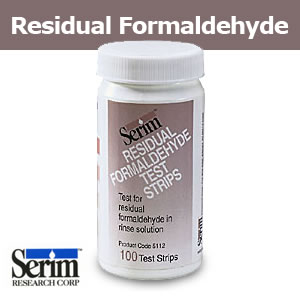
RESIDUAL FORMALDEHYDE TEST STRIPS
Serim Residual Formaldehyde Test Strips give a semi-quantitative indication of the concentration of formaldehyde remaining after rinsing formaldehyde disinfectant from dialyzers, dialysis delivery machines, water systems or portable reverse osmosis (RO) machines.
If formaldehyde is not thoroughly rinsed
from the dialyzer, the patient will complain
of burning and itching at the vascular
access site.1 Chronic exposure to
formaldehyde can cause the formation of
anti-N erythrocyte antibodies, which has
been associated with hemolysis of the
red blood cells.1,2
AAMI recommends the residual concentration of formaldehyde be reduced to below 3 ppm.2,3
- Product Profile
- Product Uses
- How To Use
- Products
| SERIM RESIDUAL FORMALDEHYDE TEST STRIPS | |
| Features | Benefits |
| Ready-to-use strips |
|
| Quick, semi-quantitative results in 2 minutes |
|
| Test is sensitive to 1 ppm |
|
| Reliably detects residual formaldehyde in water |
|
| Simple to interpret color blocks |
|
| Simple procedure |
|
| Labeled for dialysis use5 |
|
| Sample can be dispensed onto indicator pad or strip can be held in rinse stream |
|
| Consistent color reactions |
|
| Each bottle clearly labeled with: • Lot number • Expiration date |
|
*CliniTest® Tablets are a registered trademark of Siemens Healthcare Diagnostics Inc.
References:
1.
Handbook of Dialysis, Third Edition, pg 175. JT Daugirdas, PG Blake, TS Ing. Lippincott, Williams and Wilkins
2.
AAMI Standards and Recommended Practices, Dialysis, 2008 Edition, RD47:2008 Reprocessing of dialyzers. Association for the Advancement of Medical Instrumentation. Arlington, Virginia.
3.
Proper Mechanisms for Assuring Disinfectant Concentrations for Use in Hemodialysis, Nephrology News & Issues, June 1999, pg 18-27.
4.
Handbook of Dialysis, Third Edition, pg 173. JT Daugirdas, PG Blake, TS Ing. Lippincott, Williams and Wilkins
5.
Proper mechanisms for assuring disinfectant concentrations for use in hemodialysis. Nephrol News Issues. 1999 Jun;13(6):18, 23, 27. Arduino MJ.
WHAT does this product do?
Serim Residual Formaldehyde Test Strips give a semi-quantitative indication of the concentration of formaldehyde remaining after rinsing formaldehyde disinfectant from dialyzers, dialysis delivery machines, water systems or portable reverse osmosis (RO) machines.
WHY should I use this product?
If formaldehyde is not thoroughly rinsed
from the dialyzer, the patient will complain
of burning and itching at the vascular
access site.1 Chronic exposure to
formaldehyde can cause the formation of
anti-N erythrocyte antibodies, which has
been associated with hemolysis of the
red blood cells.1,2
AAMI recommends the residual concentration of formaldehyde be reduced to below 3 ppm.2,3
WHERE do I use this product?
Use Serim Residual Formaldehyde Test Strips to test rinse solution from any convenient port after the solution has passed through the dialyzer. Test a sample of rinse solution from the drain or from the post-dialyzer recirculating line of the hemodialysis delivery system. Follow the RO manufacturer's instructions for collecting and testing samples from RO machines and water systems after disinfecting with formaldehyde.
WHEN do I use this product?
For reused dialyzers, it is important to
test each dialyzer immediately before use to ensure that the disinfectant was adequately rinsed.4 Whenever the dialysis delivery machine, RO machine or water system is disinfected with formaldehyde, use Serim Residual Formaldehyde Test Strips to ensure complete rinse-out of the disinfectant.
References:
1.
Handbook of Dialysis, Third Edition, pg 175. JT Daugirdas, PG Blake, TS Ing. Lippincott, Williams and Wilkins
2.
AAMI Standards and Recommended Practices, Dialysis, 2008 Edition, RD47:2008 Reprocessing of dialyzers. Association for the Advancement of Medical Instrumentation. Arlington, Virginia.
3.
Proper Mechanisms for Assuring Disinfectant Concentrations for Use in Hemodialysis, Nephrology News & Issues, June 1999, pg 18-27.
4.
Handbook of Dialysis, Third Edition, pg 173. JT Daugirdas, PG Blake, TS Ing. Lippincott, Williams and Wilkins
5.
Proper mechanisms for assuring disinfectant concentrations for use in hemodialysis. Nephrol News Issues. 1999 Jun;13(6):18, 23, 27. Arduino MJ.
HOW TO USE RESIDUAL
FORMALDEHYDE
TEST STRIPS
Serim Residual Formaldehyde Test Strips are supplied in ready-to-use form. When placed in contact with the sample according to the directions for use (see below), the indicator pad changes color relative to the concentration of formaldehyde present in the rinse solution.
| Test Method | Syringe or Recirculating Line | Stream from Drain |
| Sample | Dispense 1 rounded drop of rinse solution onto the indicator pad using a syringe or by breaking the recirculating saline line. | Collect 1 rounded drop of rinse solution on the indicator pad by passing the strip quickly (1 second) through the rinse stream. |
| Test Strip Technique | Allow the sample to remain on the indicator pad for 2 minutes, and then blot the side edge of the pad on a paper towel. | |
| Semi-quantitative Results | Compare the color of the indicator pad to the color blocks on the bottle label. | |
| Serim Residual Formaldehyde Test Strips must be refrigerated until needed. Allow the bottle of strips to come to room temperature prior to opening or use. The lot number and expiration date are printed on the bottom of each bottle. |
||
References:
1. Handbook of Dialysis, Third Edition, pg 175. JT Daugirdas, PG Blake, TS Ing. Lippincott, Williams and Wilkins
2. AAMI Standards and Recommended Practices, Dialysis, 2008 Edition, RD47:2008 Reprocessing of dialyzers. Association for the Advancement of Medical Instrumentation. Arlington, Virginia.
3. Proper Mechanisms for Assuring Disinfectant Concentrations for Use in Hemodialysis, Nephrology News & Issues, June 1999, pg 18-27.
4. Handbook of Dialysis, Third Edition, pg 173. JT Daugirdas, PG Blake, TS Ing. Lippincott, Williams and Wilkins
5. Proper mechanisms for assuring disinfectant concentrations for use in hemodialysis. Nephrol News Issues. 1999 Jun;13(6):18, 23, 27. Arduino MJ.
 |
RESIDUAL FORMALDEHYDE TEST STRIPS | |||
| Product | Description | Packaging | ||
| 5112 | Residual Formaldehyde Test Strips | 1 Bottle of 100 Test Strips | ||
